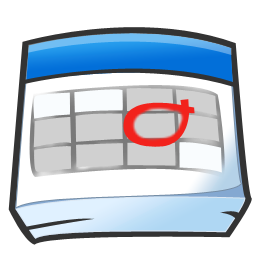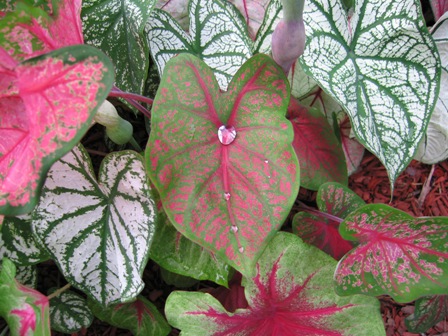Caladium is a tropical foliage plant native to Brazil. It’s considered an easy to grow plant, especially when planted in the warmer climates (zone 6-8) in the United States. In fact, 98% of caladium bulbs come from Florida, (Lake Pacid). Some folks grow them in the cooler, zone 4 climates; however, in cooler climates, they’re treated more like a houseplant or grown outside in hanging baskets.
Possessing an exotic beauty all their own, caladiums are also poisonous and may irritate sensitive skin. They should not be ingested by humans or animals.
Most caladium varieties grow to around 2 feet high and 2 feet wide although newer dwarf varieties are now available. They are an ideal choice for shady, humid areas in your yard. Proper drainage is important as is rich, slightly acidic (6.5 – 6.5 pH) soil. Amend poor soil with compost or other organic material.

When to plant:
Plant caladiums outside in the spring when the weather warms. Night temperatures need to be consistently in the 60º F range for good germination. Keep the ground moist where you planted the bulbs to ensure good germination.
Where to plant:
Plant caladiums in beds and borders and as a ground cover in areas where they can receive consistent watering. Plant in partial shade and in a location protected from the wind. The large leaves on some varieties can break off when it’s windy.

Planting depth:
Caladiums are planted shallow, to only 2 inches. Look for the eyes on the bulbs (tubers, actually) that look much like the eye of a potato; plant with the eye facing upward.
Spacing:
Caladiums should be spaced anywhere from 2″ to 12″ apart depending on the size of the bulbs being planted. Click here for more detail on bulb spacing.
How to plant caladium bulbs
Let’s face it, most bulb planting methods have us spending a lot of time bending over or on our knees. The ProPlugger 5-IN-1 Planting Tool allows you to do most of the hard work of digging your bulb planting holes from a standing position.
To pull plugs, slide the 2″ or 4″ metal depth ring onto the bottom of the main tube to set the desired depth of the planting hole. Or to dig a 6″ deep hole, no depth ring is needed.
(Step, Twist and Pour) Step down on the foot pegs until the depth ring bottoms out against the ground. Give the 5-IN-1 a slight twist to break the soil plug free and pull straight up on the handlebars. To empty the plugs, simply turn the plugger upside down and pour the plugs out of the top of the tube.
The soil gets stored inside the tool as you work, enabling you to dig over a dozen planting holes, one right after another. Place the bulb in the planting hole, pointed tip facing upward. Fill in the hole with the soil you removed with the 5-IN-1. Firm the soil over the bulb with your foot.
Feeding:
When the leaf tips begin to poke out of the ground, apply a 5-10-10 fertilizer. About the time of flowering, top dress with a 0-0-10 or 0-0-50 fertilizer. Fertilize in the spring of each year with a 5-10-10 fertilizer or all purpose fertilizer used for feeding flowers. Limit foliar feeding with fertilizer (see note below). Mulching around the plants with aged compost or well rotted manure will achieve the same effect as a light feeding of fertilizer.
Disease and pest problems:
The most common diseases are fusarium and pythium. Since these are fungal problems, prevention is key. Good air circulation and proper plant spacing goes a long way in controlling fungus problems. Fungicides such as Medallion can be used to control fusarium and Subdue to control pythium.
Potential concerns:
Tuber decay:
can present as either a dry, chalk like appearance which is caused by fungi. A soft and somewhat slimy rot can also be a problem and is caused by bacteria.
Over fertilizing:
Often caused by foliar applied fertilizers, the edges of leaves will often look burned or scorched. This can also be caused by too little water or exposure to too much sunlight.
Popular caladium varieties:
The leaves of caladiums are absolutely beautiful and there are many popular varieties to choose from, including Fancy Leaf Mix, Lance Leaf Mix, Candidum, Fanny Munson, and Carolyn Wharton.
Neil Moran is a horticulturist and author of three books on gardening. He is also the creator and author of the garden blog North Country Gardener
Additional resources:
North Carolina State University on Caladiums
Find your climate zone by zip code
Be sure to check out the helpful information on our website, including other uses for the ProPlugger including:

